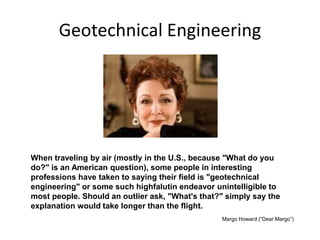The Single Strategy To Use For Geotheta
The Single Strategy To Use For Geotheta
Blog Article
Some Ideas on Geotheta You Need To Know
Table of Contents8 Simple Techniques For GeothetaMore About GeothetaHow Geotheta can Save You Time, Stress, and Money.Geotheta - Questions
They team up with civil designers, architectural engineers, engineers, and various other experts to integrate geotechnical factors to consider into the general project design and building process. This requires effective synergy, control, and interaction to make certain that the geotechnical elements line up with the project objectives and meet regulatory requirements.Mining & Materials Engineering: Principles of drilling, infiltration prices, and variables influencing the option of boring technique. Attributes of dynamites, firing systems and blast patterns. Blowing up strategies in surface area and below ground operations. Special blowing up methods at excavation perimeters. Resonance and sound control. Mechanical and constant strategies to fragmentation, consisting of longwall shearing and fullface boring.
Integrated analysis of fragmentation and comminution procedures. Provided by: Mining & Materials Design.
Indicators on Geotheta You Need To Know
Bachelor's degree programs in civil, geotechnical, geological, and ecological design normally last four years and consist of general education and learning courses in English, social science, and the humanities, in addition to training courses in innovative mathematics, structural geology, and fluid mineralogy. (https://soundcloud.com/geotheta)
Geotechnical engineering includes the analysis of the soil and rock problems at a particular website, and their effects for the advancement of that website. As most frameworks depend on the ground for support, it is without surprise that a detailed understanding of the ground conditions, and the suitability of structure systems, are important to the lasting security and efficiency of the building or framework.
Being experts in the examination of geological formations and ground practices, geotechnical designers carry out scientific investigations and screening to recognize the effect these geological developments may carry the style and construction of building, civil and facilities jobs. This experience is essential for the design and building of buildings, roads, tunnels, dams, bridges, and supply of water and sewer system.
The geotechnical team at Douglas Partners regularly seek advice from architects, design designers, designers, and building contractors to make suggestions on design and advancement proposals to make certain that the constructed frameworks are suitably developed for the ground problems. As an example, the layout of footing systems needs to consider the weight of the structure, the capability of the ground to sustain that weight with each other with movement resistances and efficient building.
The Basic Principles Of Geotheta
This task is considerably simplified by the use our Douglas Map geospatial platform that makes this info readily available in an easy to make use of internet browser user interface. A geotechnical designer will certainly direct the drilling of boreholes and test pits to accumulate dirt and various other samples, and additionally examine surface attributes and ground exposures to create a geotechnical design of the subsurface conditions.
Depending upon the job type and ground problems ran into, laboratory screening might to name a few things analyze toughness, compressibility, reactivity and/or permeability of dirt and rock examples. After this information is gathered and collated, the results are used for a geotechnical model of the website, which is commonly offered as areas throughout the website.

A geotechnical examination by nature can just assess the ground conditions at the places pierced or dug deep into. Natural variations in dirt and rock conditions can happen throughout a website and between test areas. It is for that reason great practice that the geotechnical designer be retained throughout construction of the project to offer on-site confirmation that the ground conditions run into follow the expectations and recommendations given in the geotechnical investigation report.
Getting The Geotheta To Work
Geotechnical designers utilize their thorough expertise of dirt and rock to evaluate danger and solve issues on varied facilities projectsGeotechnical design is a specialist branch of civil design which considers the behaviour of earth materials and the application of dirt and rock technicians. Consulting Engineer. As a geotechnical designer, you will certainly analyze the physical, mechanical and chemical he said residential or commercial properties of dirt and rock in order to design foundations, maintaining structures and earthworks
Geotechnical design is carefully connected to and overlaps with, both design geology and ground design - https://forums.hostsearch.com/member.php?265240-geotheta. It's possible to specialise in geotechnics or work for a geotechnical business yet be referred to as an engineering rock hound or a ground engineer. As a geotechnical engineer, you'll need to: construct and maintain connections with clients and other specialists associated with the site, throughout each projectmaintain safety requirements on site bear in mind cost implications when you make recommendationsstudy geological maps and aerial photographs from a range of sources and from different time periodsexamine construction prepares to see how viable they are based on your understanding of the siteinvestigate risks or geological hazards for the sitesearch for ecologically sensitive functions, such as landfill start to develop accurate and expository ground modelsplan field investigationsdrill and analyse samples of bedrock, soil, groundwater and extra products manage other professionals on sitesolve technical concerns as they develop, such as unexpected structures at drill sitesmonitor problems during and after building and construction to make certain frameworks are steady in the brief and long termadding information gathered on website to your first researchcreating geotechnical estimations, drawings, and two or three-dimensional computer versions interpreting the datamaking suggestions about the recommended use of the website

Report this page